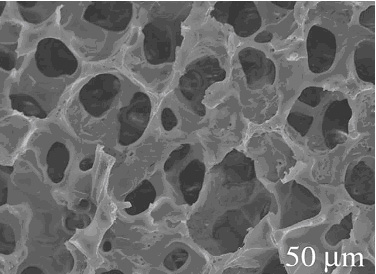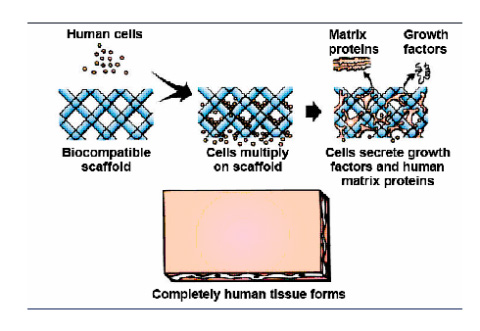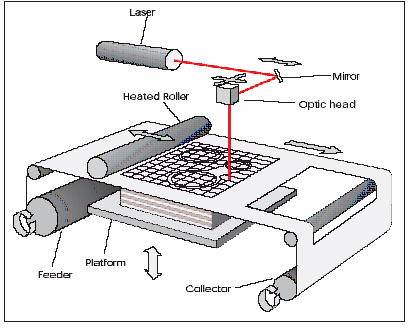Contribute
| Technology - Tissue Engineering Of Cartilage - Part 1 |
Tejashri Aurangabadkar
11/14/2005
Background Tissue engineering The success of the tissue engineering technique depends heavily on the production of constructs capable of mimicking the compositional and mechanical properties of the native cellular environmental and achievement of the functional integration between the tissues engineered constructs and the surrounding tissue after implantation. Once these scaffold constructs have been carefully designed and fabricated, cells and scaffolds are added in to bioreactor systems which are capable of supplying the necessary nutrients and circulation for cellular growth. The artificial environment simulated by these bioreactors can be precisely controlled to maximize growth production efficiency. After the tissue has been successfully grown in this environment, it can be surgically implanted to replace failing or damaged tissues. Scaffold Materials
Joint pain is a major cause of disability in middle-aged and older people. Pain usually results from degeneration of the joint's cartilage due to primary osteoarthritis or from trauma causing loss of cartilage. Cartilage is a highly specialized tissue that serves as a load bearing material of diarthroidal joints; with excellent friction and wear characteristics. It is composed of one single type of highly specialized cells called chondrocytes, embedded within a dense extracellular matrix. As many as 36 million Americans suffer from some form of arthritis and cartilage damage from sports injury is also common. It has been shown that up to 16% of injuries to the knee cause bleeding in arteries. Since cartilage shows very little tendency for self-repair, these injuries are maintained for years and can eventually lead to further degeneration (secondary osteoarthritis). Given the debilitating nature of severe joint pain, scientists and surgeons have tried for decades to repair or regenerate lost cartilage, but there has been little success due to the complex properties of the tissue and its essential function in the body. Although appearing to be a simple, avascular matrix, hyaline cartilage possesses properties, such as resistance to compression and the ability to distribute loads that cannot be fully replaced by any other tissue or device designed to date. This article will provide an overview of scaffold materials, manufacturing methods, cells and bioreactors used for tissue engineered cartilage scaffold.
At a National Science Foundation Workshop held in 1988, the term “tissue-engineering†was officially defined as “the application of principles and methods of engineering and life sciences toward fundamental understanding of structure function relationships in normal and pathological mammalian tissue and the development of biological substitutes to restore, maintain, or improve tissue functionsâ€.
There are a few basic requirements that have been widely accepted for designing polymer scaffolds.
1) A scaffold has to have high porosity and proper pore size for proper cell growth and retention.
2) High surface area is needed for enable better tissue growth in the reactor.
3) Biodegradability is generally required, and a proper degradation rate is needed to match the rate of neotissue formation.
4) The scaffold must have the required mechanical integrity to maintain the predesigned tissue structure.
5) The scaffold should not be toxic to the cells (i.e. biocompatible).
6) The scaffold should positively interact with cells, including enhanced cell adhesion, growth, migration, and differentiated function.
There are various types of materials available for tissue engineering of scaffolds, which have their own advantages and disadvantages. These are classified under three categories,
Synthetic Polymers: They are artificial e.g. Polylactic acid (PLA), Polyglycolic Acid and Copolymers (PGA), Poly (lactic-co-glycolic acid) PLGA, Poly-L-lactide (PLLA), Poly-L-lactide (PLLA), Poly (D, L-lactide) (PDLLA), Poly (e-caprolactone) (PCL), Polyethylene Oxide (PEO), Poly (Ortho Ester)
Natural Polymers: They are naturally exist in nature like Collagen, Silk, Agarose and Alginate,
Hydrogel Polymers: Hydrogels are cross-linked hydrophilic polymers that contain large amounts of water without dissolution e.g. Poly (ethylene glycol) (PEG), Poly (propylene fumarate) PPF, Fibrin
You may also access this article through our web-site http://www.lokvani.com/


scaffold


Rapid Prototyping Technique: Laminated Object Manufacturing (LOM)